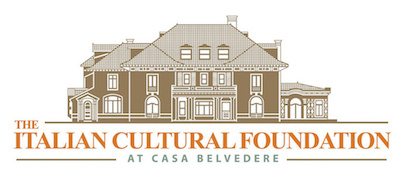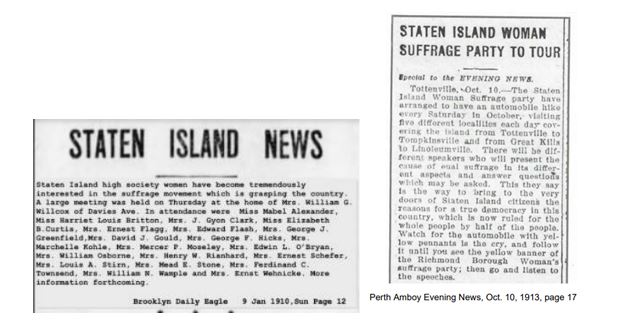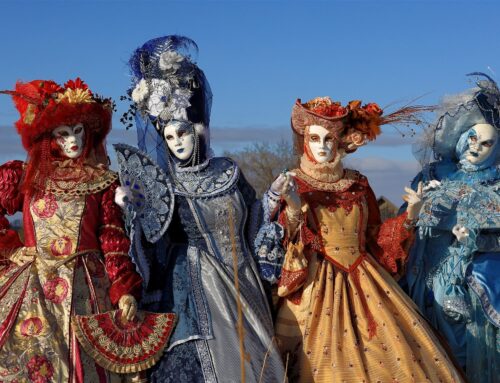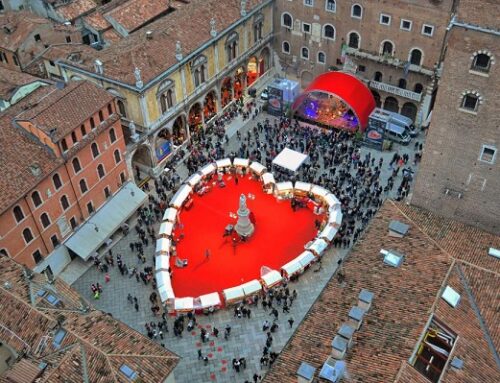By Gina Biancardi
The mansion at 79 Howard Avenue that is now Casa Belvedere was built for Louis A. Stirn and his wife, Laura Natalie Methfessel-Stirn. Louis Stirn was a successful silk merchant, but while Louis was at work, his wife was making history.
Laura Stirn was called by her middle name, Natalie, so as not to be confused with her mother Laura Roebling-Methfessel. Natalie was a woman of Staten Island’s high society in the early 1900s, living in high style with her husband and children in a Grymes Hill mansion overlooking New York City’s harbor. She enjoyed singing, cultivating rare plants, playing bridge with friends, attending social events with her husband, and supporting philanthropic causes.
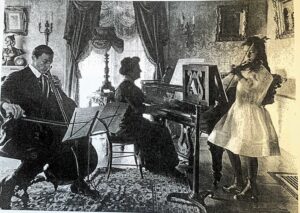
But Mrs. Louis Stirn was also civic minded, forward thinking, equalitarian, and very active in promoting women’s suffrage. Throughout the 1910s, Natalie attended women’s suffrage events, and also hosted equal rights activism events at the Stirn Mansion. She and her friends also used their social standing and their access to commercial and political influence to move men who could affect change toward enacting legislation to expand women’s suffrage.
The Stirn House is one of only two homes in Staten Island still standing that have direct links to the Suffrage Movement. The other is the George William and Anna Curtis house (234 Bard Avenue, in Staten Island’s historic district).
Historical newspaper clippings affirm that Mrs. Louis Stirn was an active participant in the local suffrage movement, and other causes that like-minded women of her age were part of as well. Historical newspaper clippings also link the Stirn House as a meeting place for women’s equal rights speeches, public events, club meetings and dissemination of women’s suffrage information.

Laura, Elizabeth, and Mary
Laura Natalie Methfessel Stirn (1864 – 1943) was the granddaughter of John A. Roebling, the man who initiated and designed the Brooklyn Bridge, and the niece of Emily Warren Roebling, wife of Washington Roebling, John’s son, and the woman who completed the bridge’s design and construction. Laura’s father, Anton Methfessel, was a scholar from Germany who in 1862 founded the Methfessel Institute, now the Staten Island Academy, one of the most prestigious private academies in the northeast. Laura’s formal education was clearly a priority for both of her parents. Laura Methfessel grew up with Charles Roebling, the youngest of John Roebling’s sons who was sent to live with the Methfessels so that he could attend the Methfessel Institute.
In 1888, Laura married Louis A. Stirn. He became a successful silk merchant and owner of textile mills, and in 1908, the couple built their country estate atop Grymes Hill on Staten Island. The house was designed by Kafka & Lindenmeyr with Italianate style exterior and an arts and crafts, mission style interior. The home’s property spans 275 feet of frontage on Howard Avenue, and 600 feet down the hillside. Louis and Laura brought much grandeur, wealth and beautification to Grymes Hill’s already extraordinary landscape.
Laura hosted outdoor parties in conjunction with the New York State Women’s Suffrage Party in the Stirn Mansion’s gardens. Laura was also active in many philanthropic activities, including three non-profit organizations: the St. Cecilia Women’s Singing Club, the Staten Island Garden Club, and the Staten Island Bird Club.
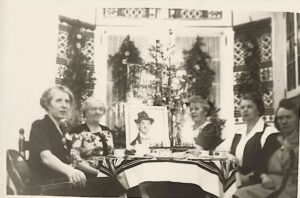
She was also an active member of the Staten Island Institute of Arts & Sciences and a member of the Board of Trustees of Staten Island University Hospital. Laura was known for her collection of rare plants, proudly displayed in her home’s lavish Octagonal Conservatory.

Laura was friends with Elizabeth B. Curtis and Mary Otis Willcox, two other Staten Island women of the same age and socio-economic category, who often participated in the same charitable causes and traveled in the same circles. The three women were frequently cited in historical newspapers as attending the same charity events. Knowing that men would ultimately decide on whether women could vote, own property, or be elected to political positions, these women also had indirect involvement in their husbands’ organizations, including the Richmond County Country Club, Staten Island Civic League, Manhattan Club, and the Staten Island Chamber of Commerce.
Elizabeth Burrill Curtis (1861 – 1914) proudly carried on the progressive legacy of the Shaw and Curtis families as a vocal advocate for voting rights and civic education for women. At the 1894 New York State Constitutional Convention, Curtis argued, “Because the protection and safety of the home are so vital to most women … I plead for the power to effectually guard that home.” Though Elizabeth’s efforts were unsuccessful at the 1894 convention, she continued her fight for equal rights for women. Curtis founded the Staten Island Political Equality Club in 1895, “the first organization on Staten Island to preach the equality of women and men.” An 1896 Ladies’ Home Journal article described blue-eyed Elizabeth as having a “strong personality” and precociously reading Shakespeare as a child; a “scholar” of French and German; lover of history; and possessing “energy of character and executive ability … the mind of a man, with a woman’s heart and tenderness.” After Curtis’ death in 1914, fellow suffragist Mary Otis Willcox said of Curtis’ contribution to the movement, “By the force of her personality [she] raised the cause from a subject of ridicule to one at least for serious consideration.”
Mary Otis Willcox (1861 – 1933) began her suffrage work as an officer in the Political Equality Club in 1895, and in 1914 spearheaded the local suffrage campaign as chair of the Staten Island Woman Suffrage Party. A wealthy woman, Willcox was able to host many of the Party’s events in her home, provide her car to transport suffrage speakers around the island, and give generously to the movement’s fundraising efforts for lobbying, advertising and political organization. She and her husband, William G. Willcox, also supported all the Staten Island’s charitable organizations stated above, as well as the Red Cross. Upon Mrs. Willcox death in 1933, the Staten Island Institute of Arts & Sciences (later to become the Staten Island Museum) recognized Mary Otis Willcox as one the first women to serve on its Board of Trustees. Mrs. Louis A. Stirn was also a founding Board of Trustees member of the Staten Island Institute of Arts & Sciences, serving with Mrs. William Willcox.
Significant suffrage events in Staten Island
Staten Island played a significant role in the struggle to achieve basic American liberties for women, with nationally historic events and active participants. One of the largest suffrage events in the country occurred at the Interborough Fair Grounds in Dongan Hills, Staten Island in 1915. It was Women’s Club Day at the fair, which The New York Times headlined as “Suffragists Out In Force,” with thousands of people in attendance from New York, Massachusetts, Connecticut and other states. The Times describes speakers addressing broad topics ranging from peace and good government to public education, art, music, philanthropy, medicine, all aiming to help women become more informed citizens, as well as to raise awareness about voting rights. The Times article also announced, with great surprise, that the popularity of the women’s speeches surpassed the fair’s horse race viewing.
A second notable suffrage event relating to Staten Island was the planned “bombing” of leaflets on President Woodrow Wilson while he was in New York City in December 1916. Leda Richberg-Hornsby was to fly her plane from Midland Beach and drop leaflets on Wilson’s yacht, The Mayflower, as it traveled down the Hudson. The mission failed when high winds forced Richberg-Hornsby to crash land the plane in a Staten Island swamp.
These noteworthy events stand among examples of ongoing social gatherings, club meetings and other low-key interactions where activists for women’s suffrage shared their views and beliefs with their networks to build support for expansion of suffrage to women.
The Staten Island Museum is currently offering a public exhibit, three years in the making, titled “Women of the Nation Arise!” The exhibit commemorates the 19th Amendment’s centennial anniversary and honors Staten Island’s gutsy suffragists of the early 1900s. These women brought the movement from neighborhood parlors to the streets of New York City, to county fairs and even to the skies above it.
By 1916, many Staten Island women were active in the Staten Island Suffrage movement, with over 10,000 members recruited by the time New York state voters passed the amendment that gave women the right to vote in 1917. Also, suffragists across the nation took bold action to raise awareness about their cause by organizing marches, protests, and spectacles to create momentum for legislation, culminating in the ratification of the 19th Amendment to the US Constitution in 1920.
This singular event was made possible by decades of education, recruiting, protesting, advocating and other activism performed by women and men in New York and across the country. Experiences of local activists on the path toward suffrage shed light on the importance of the steps taken to achieve their goal.
Any historic place offers a lens to a unique story in America’s cultural heritage: while touring the Stirn house, visitors will experience the depth and scope of its history and hear its full story. They will learn about Laura Natalie Methfessel–Stirn’s important place in high society, about her fascinating Roebling relatives, and about the suffrage movement she and her husband championed on the very grounds of what is now known as the Italian Cultural Foundation at Casa Belvedere.
For a special video presentation about Women’s Suffrage in Italy, click here.
